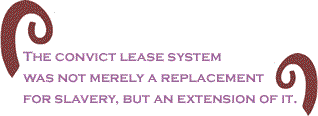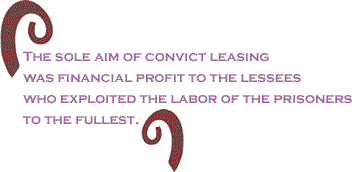
|
|||||||||||||||||||||
|
One popular method of controlling ex-slaves, while perpetuating a form of slavery, was convict leasing. This was introduced throughout the South because “free” blacks represented such a threat to white supremacy, convict leasing would be just another form of chattel slavery that would function to keep the black race in a subordinate position. Some might argue that this was one way to provide an abundant source of cheap labor to help re-build the war-torn South. While this is no doubt partly true and an abundant supply of cheap labor was in fact readily available, this form of labor was not much of a help in the enormous task of rebuilding that faced the South. The subjugation of African-Americans became common throughout the South after the war. Several laws were passed (or old ones were reinstituted) which helped keep the African-American population in its place, such as vagrancy, loitering, disturbing the peace, and Jim Crow laws, to name just a few. When these methods failed, the use of force was relied upon, especially lynching (and lynchings increased after the war). Indeed, as several writers have documented, the use of force to keep African-Americans in a subordinate position increased dramatically after the war, one example being the rise of the Ku Klux Klan.
One result of this practice was the shift in prison populations to predominately African-American following the war. Data for Tennessee prisons demonstrates this change. African-Americans represented only 33 percent of the population at the main prison in Nashville as of October 1, 1865, but by November 29, 1867, the percentage had increased to 58.3. By 1869 it had increased to 64 percent and it reached an all-time high of 67 percent between 1877 and 1879; a slight decrease in the number of inmates (especially African-American) between 1880 and 1898 can be explained in part by the opening of two branches of the main prison, Brushy Mountain and Inman, in the 1890s. The population of Brushy Mountain Prison was predominantly African-American, much more so than at the main prison. The only data available for the Inman branch are for prisoners on hand as of December 1, 1898. At that time there were only 58 prisoners, all of whom were African-American. Data from other states also illustrate the predominance of African-Americans in the Southern prison system after the war. In 1888 the prison at Baton Rouge, Louisiana, held 85 whites and 212 African-Americans; in 1875 in North Carolina 569 African-Americans and 78 whites were sentenced to prison. The actual increase in the populations within Southern prisons is staggering. In Georgia there was a tenfold increase in prison populations during a four-decade period (1868-1908); in North Carolina the prison population increased from 121 in 1870 to 1,302 in 1890; in Florida the population went from 125 in 1881 to 1,071 in 1904; in Mississippi the population quadrupled between 1871 and 1879; in Alabama it went from 374 in 1869 to 1,878 in 1903 and to 2,453 in 1919.
Convict leasing involved leasing out prisoners to private companies that paid the state a certain fee. The convicts worked for the companies during the day (convicts were usually not paid) outside the prison and returned to their cells at night. Criminologist Thorsten Sellin, in his book Slavery and the Penal System, says that the sole aim of convict leasing “was financial profit to the lessees who exploited the labor of the prisoners to the fullest, and to the government which sold the convicts to the lessees.” One example was a lease system in Alabama. Sellin explains it as follows:
In Tennessee by 1870 convicts were being leased from the main prison at Nashville to three separate railroad companies in Tennessee. During the 1880s the legislature appropriated about $14 million to relieve the railroad companies that had suffered great losses during the war. It is no exaggeration that convicts rebuilt Tennessee's railroads. In 1871 coal mining companies began to use convict labor and by 1882 more than half of the convicts at the Nashville prison were leased out. In 1884 the Tennessee Coal, Iron and Railway Company took complete control and leased the entire prison population. A sociologist once described how one company, especially the owner Joseph E. Brown, made huge profits from convict leasing in Georgia:
The convict lease system was cruel and inhumane, to say the least. Deaths were common and the treatment caused much sickness and suffering. In a coal mine in Georgia convicts were routinely whipped if they did not produce the daily quota of coal. In Alabama inmates were punished by being placed in a “sweat box” during the day in the hot sun. A Louisiana newspaper reported that “it would be more humane to impose the death sentence upon anyone sentenced to a term with the lessee in excess of six years, because the average convict lived no longer than that.” Indeed, the death rate in 1896 was 20 percent. The mortality rate for inmates in the South was 41.3 per thousand convicts, compared to a rate of 14.9 in the North.
The ideology of white supremacy dominated the entire leasing system. One writer has noted that the “lessees regarded black labor as a commodity inseparable from the convicts themselves, much as slaveholders had regarded slaves.” At the same time, such a system also fit in well with the emerging industrial capitalist system. Indeed, it can be said that the labor of convicts “depended upon both the heritage of slavery and the allure of industrial capitalism.” The convict lease system was not merely a replacement for slavery, but an extension of it, albeit in a new form and serving new interests. The control of the black labor force, writes Criminologist Mark
Colvin, “was a constant goal of the southern punishment system since
the Civil War. This labor control function was enhanced with the
rise of industrialism in the ‘New South,’ rather than eliminated.”
The convict lease system, as such, disappeared, yet other forms of convict labor continued (and still exist today) in various forms. Prison historian Blake McKelvey notes that “the lease system was doomed by its decreasing usefulness to the state, and it was not abandoned until profitable substitutes were perfected.” These other systems included plantations, industrial prisons, and the famous “chain gang.” The chain gang actually developed alongside the convict lease system as one of the two major forms of convict labor. Sociologist Robert Weiss provides us with the following graphic description of this system: “Chained together in fetid bunkhouses, suffering malnutrition and exposed to rampant disease, these hapless charges suffered one of history's most degrading punishments.” It should be noted that the vast majority of those on these chain gangs were African-Americans, often convicted for merely being black. If you think chain gangs are part of the distant past, think again. This is explained in the third and final installment of this series. Randall G. Shelden is Professor of Criminal Justice at the University of Nevada-Las Vegas. He is the author and co-author of several books on crime and criminal justice, including Controlling the Dangerous Classes: a Critical Introduction to the History of Criminal Justice, Criminal Justice in America: a Critical View, Girls, Delinquency and Juvenile Justice and Youth Gangs in American Society. His latest book is Delinquency and Juvenile Justice in American Society, to be released this summer. A more detailed version of this series, complete with footnotes, is available on his web site: www.sheldensays.com. |
Your comments are always welcome. Visit the Contact Us page to send e-Mail or Feedback or Click here to send e-Mail to [email protected] e-Mail re-print notice
If you send us an e-Mail message we may publish all or part of it, unless you tell us it is not for publication. You may also request that we withhold your name. Thank you very much for your readership. |
| June 16 2005 Issue 142 |
|||||||||
|
|||||||||
|
|
|||||||||
| Printer Friendly Version | |||||||||
 |
|||||||||
 |
|||||||||
| |
|||||||||
| |
|||||||||




























